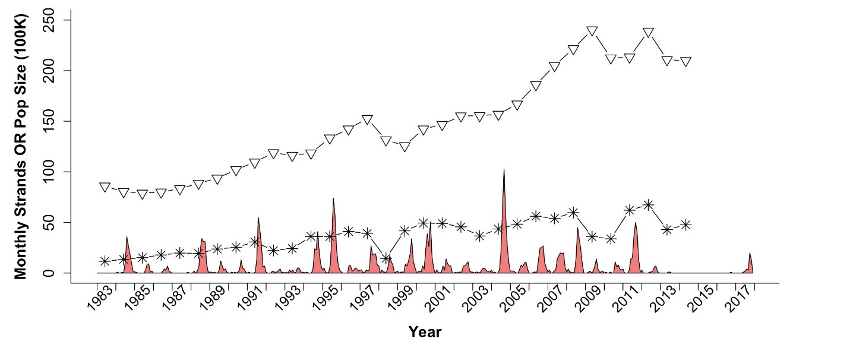Fade-Out of an Endemic Pathogen in a Wildlife Host: Did Environmental Stress Cause Apparent Disappearance of Leptospira from the California Sea Lion Population (Prevalence of Potential Pathogens from Blood, Oropharyngeal and Cloacal Mucosa of Diamondback Terrapins)?
Abstract
Leptospira interrogans serovar Pomona was first detected in California sea lions (Zalophus californianus) during an outbreak in 1970.1 Data from The Marine Mammal Center (TMMC, Sausalito, CA) stranding record indicate that since at least 1984, yearly seasonal outbreaks have occurred, with very large outbreaks occurring every 3–5 years2,3 (Fig 1). Genetic, serologic and other data support the hypothesis that California sea lions maintained unbroken transmission of Leptospira between outbreaks, probably via chronic shedders,3-7 suggesting that this is an endemic pathogen. In 2010, we began tracking Leptospira exposure (serum anti-Leptospira antibodies via microscopic agglutination test - MAT) and incidence (leptospires in urine via real-time qPCR) in wild-caught California sea lions sampled throughout their range to complement similar exposure and incidence data from the stranded sea lions at TMMC, and to better understand sea lion-Leptospira dynamics. Intriguingly, during a four-year period (mid-2013 to mid-2017) only one case of leptospirosis was detected in sea lions at TMMC, antibody titer magnitude in seropositive sea lions was low and declining, all animals born during this period were seronegative, and leptospire shedding was detected in only one out of 1242 stranded and wild-caught animals tested (prevalence = 0.0008, 95% CI = 2 x 10-5 – 0.004). In addition, after the last major outbreak in 2011 until mid-2017, yearly anti-Leptospira antibody seroprevalence in both the stranded and free-ranging populations declined, approaching zero. These data show an unprecedented four-year lull in Leptospira activity in sea lions. We conclude that, despite detection of pathogen re-emergence in mid-2017 when over 52 sea lions stranded with leptospirosis (Fig 1), these data suggest that Leptospira transmission among California sea lions essentially ceased during this period, leading to pathogen fade-out from their population. We hypothesize that this fade-out event was driven by recent oceanographic anomalies through the combined action of two mechanisms: (1) reduced buildup of susceptibles due to reduced pup production and increased pup mortality;8 and (2) changes in age and sex specific movement patterns which altered population mixing and hence transmission dynamics. Study of the re-emergence of Leptospira in California sea lions in 2017 will provide further insight into the mechanisms behind the pathogen’s apparent fade-out.
Figures
| Figure 1 | 
Number of California sea lions stranding each month from leptospirosis and being treated at The Marine Mammal Center between January 1983 and December 2017 in red; and yearly pup (1.5 months old, *) and non-pup counts (triangle) for the California sea lion population.
|
|
| |
Acknowledgements
The authors would like to thank our collaborators from The Long Marine Laboratory at the University of California, Santa Cruz, The Marine Mammal Laboratory (NOAA/NMFS), Oregon and Washington Departments of Fish and Wildlife, and Año Nuevo State Park. The authors would also like to thank the following funding sources: the National Science Foundation (OCE-1335657), the US Department of Defense (SERDP RC01-020/RC-2635), the National Marine Fisheries Service John H. Prescott Marine Mammal Rescue Assistance Grant Program, The Hellman Family Foundation, the UCLA De Logi Chair in Biological Sciences, and NIH Fogarty RAPPID.
* Presenting author
Literature Cited
1. Vedros NA, Smith AW, Schonewald J, Migaki G, Hubbard RC. Leptospirosis epizootic among California sea lions. Science. 1971;172(3989):1250–1251.
2. Gulland FMD, Koski M, Lowenstine LJ, Colagross A, Morgan L, Spraker T. Leptospirosis in California sea lions (Zalophus californianus) stranded along the central California coast, 1981–1994. Journal of Wildlife Diseases. 1996;32(4):572–580.
3. Lloyd-Smith JO, Greig DJ, Hietala S, Ghneim GS, Palmer L, St Leger J, Grenfell BT, Gulland FM. Cyclical changes in seroprevalence of leptospirosis in California sea lions: endemic and epidemic disease in one host species? BMC Infectious Diseases. 2007;7:125–136.
4. Zuerner RL, Alt DP. Variable nucleotide tandem-repeat analysis revealing a unique group of Leptospira interrogans serovar Pomona isolates associated with California sea lions. Journal of Clinical Microbiology. 2009;47(4):1202–1205.
5. Prager KC, Greig DJ, Alt DP, Galloway RL, Hornsby RL, Palmer LJ, Soper J, Wu Q, Zuerner RL, Gulland FM, et al. Asymptomatic and chronic carriage of Leptospira interrogans serovar Pomona in California sea lions (Zalophus californianus). Veterinary Microbiology. 2013;164(1–2):177–83.
6. Prager KC, Alt DP, Buhnerkempe MG, Greig DJ, Galloway RL, Wu Q, Gulland FMD, Lloyd-Smith JO. Antibiotic efficacy in eliminating leptospiruria in California sea lions (Zalophus californianus) stranding with leptospirosis. Aquatic Mammals. 2015;41(2):203–212.
7. Buhnerkempe MG, Prager KC, Strelioff CC, Greig DJ, Laake JL, Melin SR, DeLong RL, Gulland FM, Lloyd-Smith JO. Detecting signals of chronic shedding to explain pathogen persistence: Leptospira interrogans in California sea lions. J Anim Ecol. 2017;86(3):460–472.
8. Laake JL, Lowry MS, Delong RL, Melin SR, Carretta JV. Population growth and status of California sea lions. The Journal of Wildlife Management. 2017: doi:10.1002/jwmg.21405.